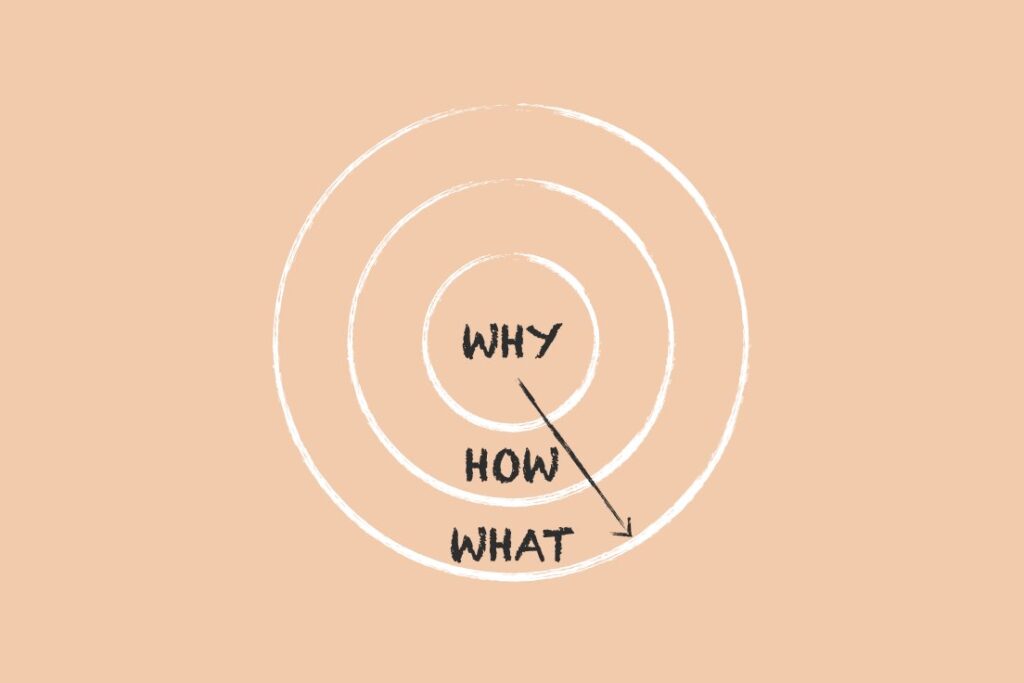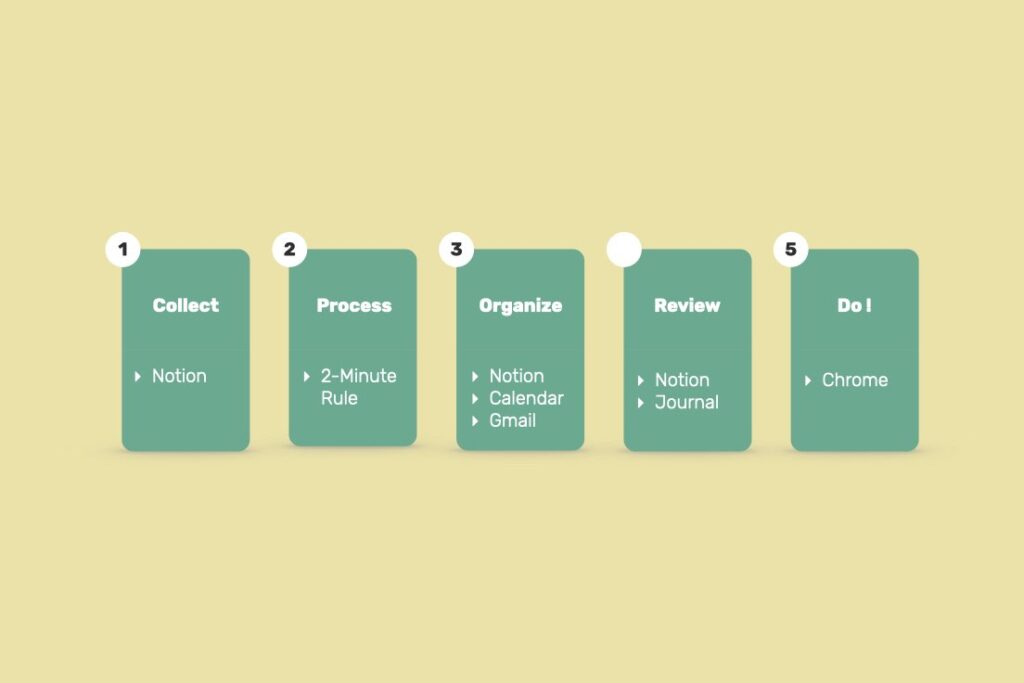
In today’s world, yesterday’s methods simply don’t work anymore. In ‘Getting Things Done‘, David Allen describes the art of stress-free productivity and performance.
His practical methods are based on the premise that our productivity is directly proportional to our ability to relax.
Only when our minds are clear and our thoughts are organized can we achieve effective productivity and unleash our creative potential.
However, the HOW is only one crucial question, alongside the what and why.
In the following, I will primarily address the HOW, because the WHY is still a mystical process for me, which depends very much on our lifestyle, our ambitions and goals, our circumstances (family, health), and thus our self-realization.

The Golden Circle
In his famous Ted-Talk, Simon Sinek describes “the golden circle” – a simple but powerful model that starts with the question “Why?
Clarity about the [WHY]
Very few people or companies can clearly articulate WHY they do what they do. This is not about running a profitable business or beating even more out of our limited time. A profitable business is a result, not a why.
We need to answer deeper questions: Why is it all about your purpose? Why does your business exist? Why do you get out of bed in the morning? And why should anyone care?
The discipline of [HOW]
Some people and businesses know HOW they do what they do. Whether you call it a differentiating value proposition or a unique selling proposition, the HOW is often taken as the answer to describe whether something is different or better.
Consistency of [What]
Every single company in the world knows what it is doing. This is true no matter how big or small the company is, or what industry it is in. Anyone can easily describe the products or services a company sells or the job function we have in the company.
In seinen berühmten beschreibt Simon Sinek “den golden Kreis” – ein einfaches, aber mächtiges Modell, das mit der Frage “Warum?” startet.
The foundation of my productivity system
Besides the golden circle and the continuous question “why”, my productivity system maximises four principles:
- The Pareto Principle: Being Effective
- The Parkinson Principle: Be Efficient
- The Liar Principle: Be radically honest
- The Zen Principle: Be Mindful
My productivity system is based on the work and discoveries of proven experts who deserve great recognition.
- Simon Sinek: Start With Why
- Carl Newport: Deep Work
- Gary Keller & Jay Papasan: The One Thing
- David Allen: Getting Things Done ‘GTD’
- Tim Ferriss: ‘4-Hour-Work Week’
- James Clear: Atomic Habits
- Steven Pressfield: Do the Work | The War of Art

Benefits of the GTD-System
The benefits of a productivity system are manifold and sustainable. Only a system supports our daily actions by forming effective and healthy habits.
- Productivity is a skill we learn.
- Using a system teaches us productivity.
- Systems create habits.
- Systems avoid complexity.
- Systems need reflection.
- Systems are conscious choices.

David Allen’s book ‘Getting Things Done‘ summarized
The book in three sentences:
- If we don’t manage the “loose ends” in our lives appropriately, our attention will always wander there.
- Overwhelming is not clarifying what your intended outcome is, not deciding what the next action is, and not remembering your intended outcome and action.
- We need to transform all the “stuff” we attract and accumulate into meaningful actions, projects and usable information by taking a clear inventory.
The five big ideas
- Getting things done requires defining what ‘done’ means and what ‘done’ looks like.
- Mastering the workflow involves capturing what catches our attention, clarifying what it means, placing it where it belongs, reviewing it regularly and addressing it.
- If an action takes less than two minutes, it should be done at the time it is defined.
- Anxiety and guilt come not from having too much to do, but from breaking agreements with yourself.
- Our mind is for creating ideas, not for remembering them.

The five essential GTD-steps
- Collect
- Decide
- Organize
- Review
- Do!

#1: Collect
The goal is to keep nothing in mind.
- Everything has to be captured. Every email. Every letter. Every phone call. Every idea. Every appointment.
- Our recording system should have as few ‘inputs’ as possible.
- We need to empty the inboxes regularly.

#2: Process (a.k.a. Decide)
In the processing stage, all inputs are emptied. David Allen describes this as perhaps the most critical improvement for almost all the people he has worked with and describes this process in great detail, complete with a flow chart.

The process suggests the following questions and steps:
- What is it? Is it realisable?
- If not, dispose of it, put it in the “maybe” or file it as a “reference”.
- If yes, what is the next action? The next action is defined as the next physical, visible activity to engage in to complete the action.
- Does the next action take less than 2 minutes?
- If yes, do it.
- If no, delegate or postpone it.
- If it takes longer than 2 minutes, consider it a project (defined as requiring more than one action step) and add it to your project plans to be reviewed later for next actions.
Note: It’s OK to decide, not to decide about something. You just need a decision-making system for open decisions to get it out of your head.

#3: Organize
The main reason for organising is to reduce cognitive load, that is, the need to constantly think, “What do I need to do next?”
Checklists can be very useful in telling you what not to worry about, as Atul Gawande proves in his book “The Checklist Manifesto“.
So in order to organise actions, lists are needed.
There are seven things you want to keep track of and manage from an organisational and operational perspective:
- Projektliste – just an index
- Project support (Details, plans and supporting information should be separate from the project list. Each project gets a folder).
- Calendar-specific actions and information
- Time-specific actions (e.g. appointments, meetings etc.)
- Date-specific actions
- Date-specific information (e.g. birthdays)
- Waiting-for
- References
- Maybe
- Holiday and activities
- Surprises
- Gift ideas
- Business ideas
- …
- List for next action — which can be categorized as follows:
- Calls
- Office
- At home
- Meetings
- Reading
- Waiting for
- References
- Maybe

#4: Review
When?
- Every last Sunday of the month to prepare the month.
- Every week on Sunday as preparation for the week
- Every morning as preparation for the day
The key components of “relaxed” review are:
- Clearly defined outcomes (projects) and the next steps to bring them to completion.
- Reminders in a trusted system that is regularly reviewed.
The 6-step model for reviewing your own work:
- 50,000 Flight altitude: Life
- 40,000 Flight altitude: 3-5-year vision
- 30,000 Flight level: 1-2-year vision
- 20,000 Flight level: Areas of responsibility
- 10,000 Flight level: Ongoing projects
- Runway: Ongoing actions

#5: Do!
2 models for selecting the next actions are presented in the book.
1: Four criteria for selecting actions in the Now:
- Context (action and location-specific)
- Left-overt time
- Left-over energy Energie
- Priority
2: Evaluate daily work by identifying 3 different things from activities:
- Perform predefined work
- Perform spontaneous work
- Define work

Effective execution of projects
According to David Allen, there are five phases of natural project planning and a project for him is any desired outcome that requires more than one action.
- Definition of purpose and principles
- Result visualisation
- Brainstorming (e.g. mind map)
- Organisation
- Identification of next actions (monthly, weekly & daily)
How much planning is needed?
The simple answer is, as much as necessary to get the project out of your head.
If you still have the project in your head, further consideration is required.
David Allen gives us rough estimates for projects, which I can confirm from my own 10 years of experience as an entrepreneur and consultant:
80% need no more than a list of their outcome and next actions to get them off the ground.
- 15% or so might require at least brainstorming (perhaps a mind map or some notes), which is sufficient for planning meeting schedules, your holiday or a speech.
- 5% or so might require the deliberate use of one or more of the five phases of the natural planning model (see above).
3 steps for getting started
- The big planning tool is a mind map: This can be done on paper (take a photo) or an app like Mindmeister (save project folder).
- Weekly planning is a Kanban board: This can be visualized on paper or in an app like Trello. Visualizing our work greatly increases our productivity.
- Daily planning is a to-do list (one column of the Kanban board) and your calendar.

Form habits and measure productivity
Here are my favourite ways to measure productivity and form habits:
- Fill your calendar with all the activities you have done (based on your categories).
- Before you start your daily work, set one to three main tasks for the day
- Fill in a short survey each day, which takes 2 minutes, to measure your productivity.
- Create reminders so that you match your ‘task being done’ (e.g. making a presentation) with your ‘main task’ (e.g. invoicing).
- Reflect at the end of the month on productivity based on your survey responses so that you can identify patterns and improve.
- Set an improvement target for the following month.

Which apps do I use to implement GTD?
I only use a few apps for my productivity system:
- Notion (used to be Evernote)
- Gdrive for project materials
- Gmail — GTD-empowered
- Calender
- Chrome using valuable add-ons such as Momentum

I hope you enjoyed the summary as a renewal or refresher of your knowledge.
Our success lies in learning and applying what we have learned.
I hope you enjoy using your own productivity system.